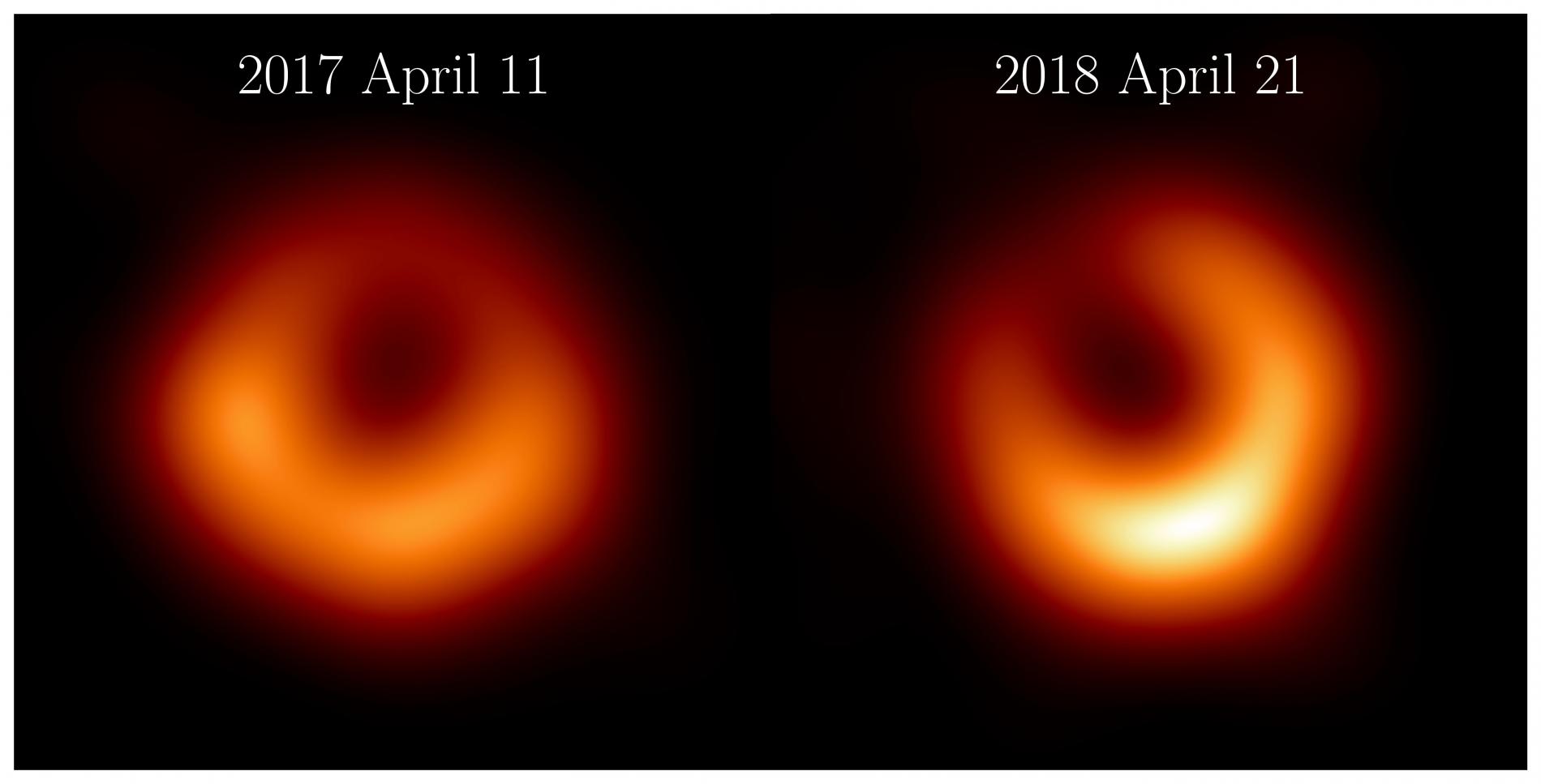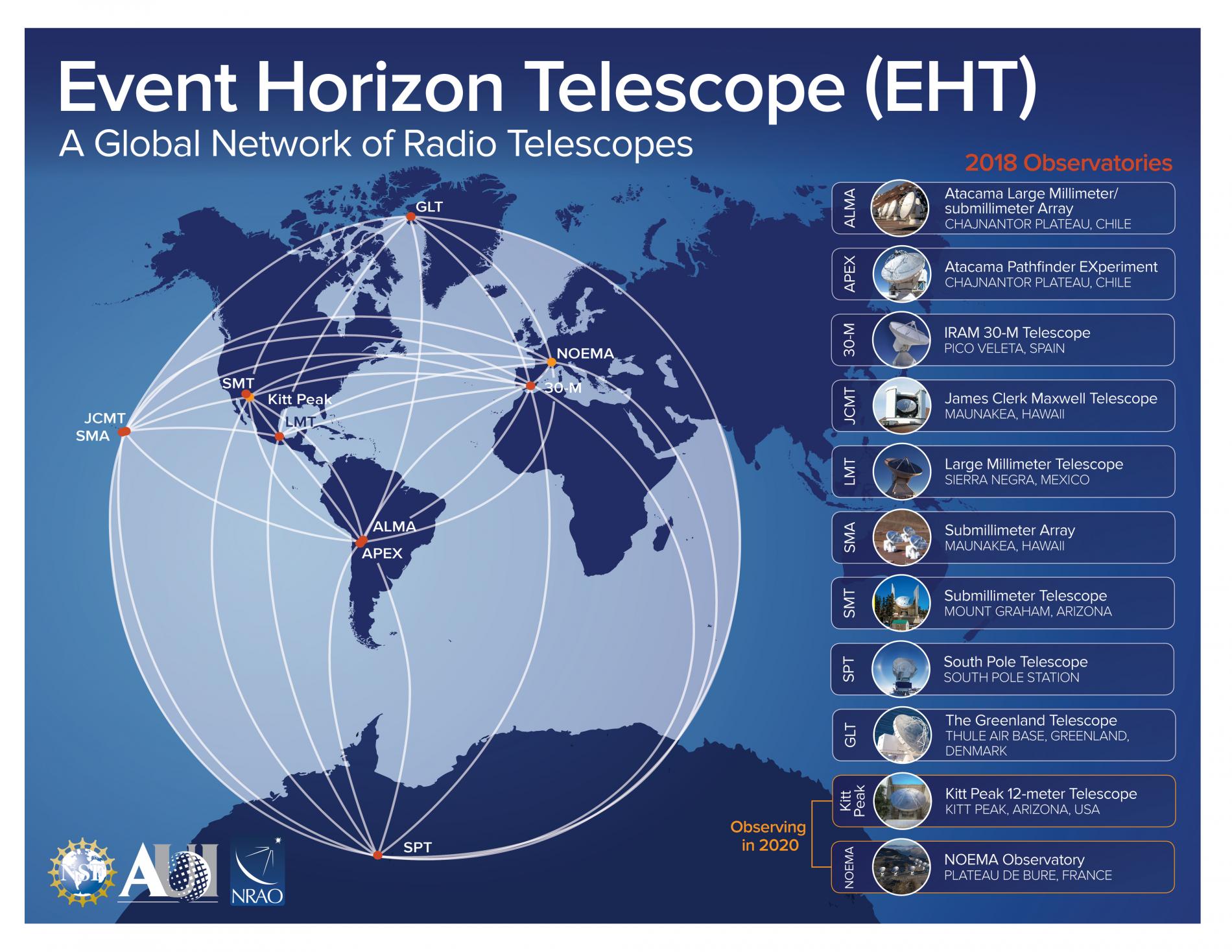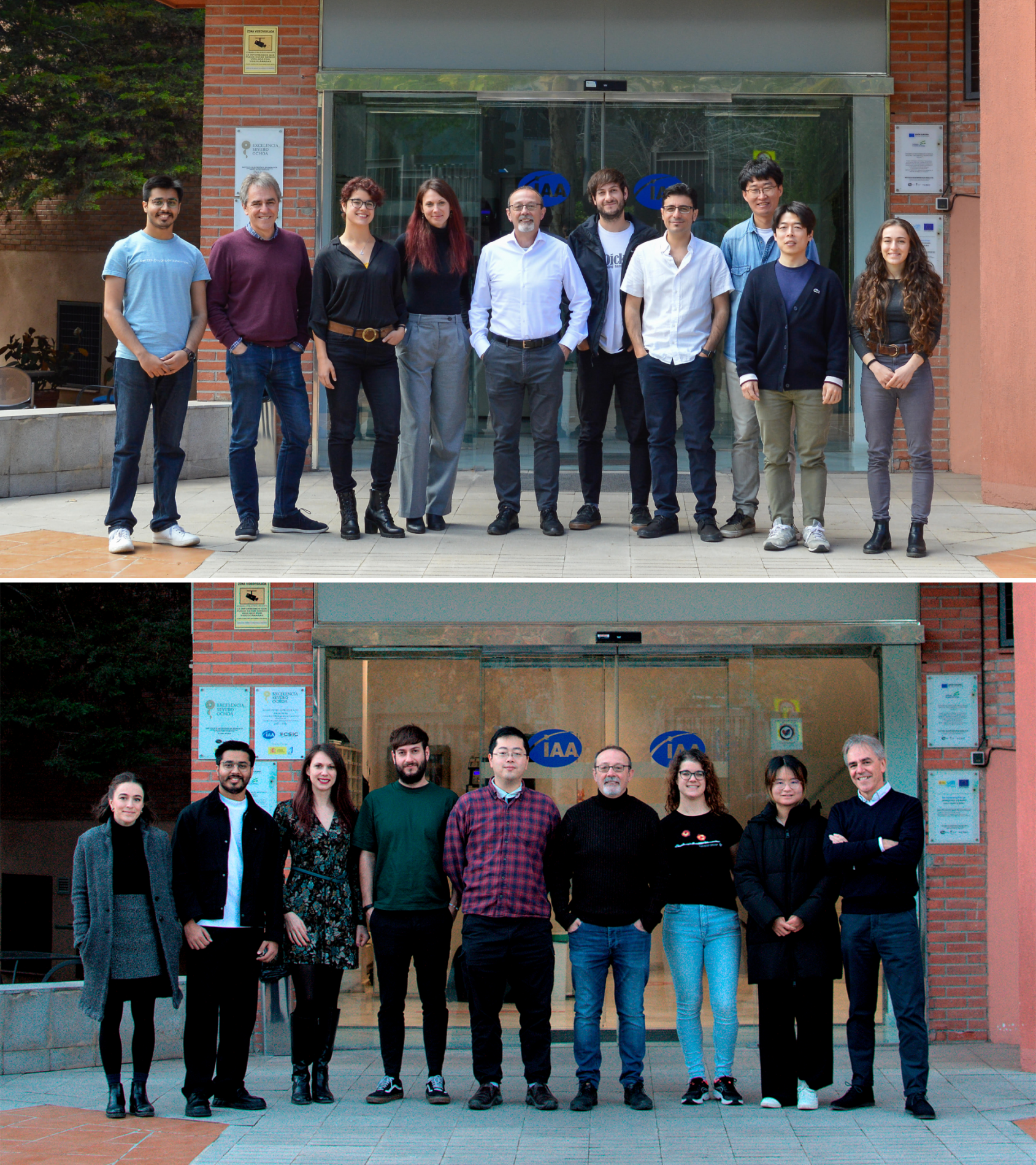M87* One Year Later: Proof of a persistent black hole shadow
The Instituto de Astrofísica de Andalucía (IAA-CSIC) participates in the international collaboration that confirms the existence of a bright ring corresponding to the shadow of the black hole in the Messier 87 galaxy.
The stability of the diameter of the ring with respect to the data obtained in 2017 supports the conclusion that the black hole M87 is correctly described by the theory of general relativity.
The Event Horizon Telescope (EHT) Collaboration, including researchers from the Instituto de Astrofísica de Andalucía (CSIC), has released new images of M87*, the supermassive black hole at the center of the galaxy Messier 87, using data from observations taken in April 2018. With the participation of the newly commissioned Greenland Telescope and a dramatically improved recording rate across the array, the 2018 observations give us a view of the source independent from the first observations in 2017.
A recent paper published in the journal Astronomy & Astrophysics presents new images from the 2018 data that reveal a familiar ring the same size as the one observed in 2017. This bright ring surrounds a deep central depression, “the shadow of the black hole,” as predicted by general relativity. Excitingly, the brightness peak of the ring has shifted by about 30º compared to the images from 2017, which can be explained based on our theoretical understanding of variability from turbulent material around black holes.

The Event Horizon Telescope Collaboration has released new images of M87* from observations taken in April 2018, one year after the first observations in April 2017. The new observations in 2018, which feature the first participation of the Greenland Telescope, reveal a familiar, bright ring of emission of the same size as we found in 2017. This bright ring surrounds a dark central shadow, and the brightest part of the ring in 2018 has shifted by about 30º relative from 2017 to now lie in the 5 o’clock position. Credit: Event Horizon Telescope Collaboration
“A fundamental requirement of science is to be able to reproduce results,” says Dr. Keiichi Asada, an associate research fellow at Academia Sinica Institute for Astronomy and Astrophysics in Taiwan. “Confirmation of the ring in a completely new data set is a huge milestone for our collaboration and a strong indication that we are looking at a black hole shadow and the material orbiting around it.”
In 2017, the EHT took the first image of a black hole. This object, M87*, is the beating heart of the giant elliptical galaxy Messier 87 and lives 55 million light years away from Earth. The image of the black hole revealed a bright circular ring, brighter in the southern part of the ring. Further analysis of the data also revealed the structure of M87* in polarized light, giving us greater insight into the geometry of the magnetic field and the nature of the plasma around the black hole.
“The new era of black hole direct imaging, spearheaded by the extensive analysis of the 2017 observations of M87* opened a new window that let us investigate black hole astrophysics and allow us to test the theory of general relativity at a fundamental level”, says Dr. José L. Gómez, vice-chair of the EHT Science Council and head of the EHT group at the IAA-CSIC, which includes also Drs. Kotaro Moriyama, Thalia Traianou, Antonio Fuentes, Antxon Alberdi, and PhD candidates Rohan Dahale, Marianna Foschi, and Teresa Toscano, and former members Drs. Ilje Ilje Cho, Rocco Lico and Guang-Yao. “Our theoretical models tell us that the state of the material around M87* should be uncorrelated between 2017 and 2018. Thus, repeated observations of M87* will help us place independent constraints on the plasma and magnetic field structure around the black hole and help us disentangle the complicated astrophysics from the effects of general relativity”, adds Gómez.
To help accomplish new and exciting science, the EHT is under continuous development. The Greenland Telescope joined the EHT for the first time in 2018, just five months after its construction was completed far above the Arctic Circle. This new telescope significantly improved the image fidelity of the EHT array, improving the coverage, particularly in the North-South direction. The LMT also participated for the first time with its full 50 m surface, greatly improving its sensitivity. The EHT array was also upgraded to observe in four frequency bands around 230 GHz, compared to only two bands in 2017.
"Advancing scientific endeavors requires continuous enhancement in data quality and analysis techniques" said Rohan Dahale, a PhD candidate at IAA-CSIC who has made an essential contribution to the new EHT results. "The inclusion of the Greenland Telescope in our array filled critical gaps in our earth-sized telescope. The 2021, 2022, and the forthcoming 2024 observations witness improvements to the array, fueling our enthusiasm to push the frontiers of black hole astrophysics."
CONSISTENCY WITH GENERAL RELATIVITY
The image of M87* taken in 2018 is remarkably similar to what we saw in 2017. We see a bright ring of the same size, with a dark central region and one side of the ring brighter than the other. The mass and distance of M87* will not appreciably increase throughout a human lifetime, so general relativity predicts that the ring diameter should stay the same from year to year. The stability of the measured diameter in the images from 2017 to 2018 robustly supports the conclusion that M87* is well described by general relativity.
“One of the remarkable properties of a black hole is that its radius is strongly dependent on only one quantity: its mass” said Dr. Nitika Yadlapalli Yurk, a former graduate student at the California Institute of Technology (Caltech), now a postdoctoral fellow at the Jet Propulsion Laboratory in California. “Since M87* is not accreting material (which would increase its mass) at a rapid rate, general relativity tells us that its radius will remain fairly unchanged over human history. It’s pretty exciting to see that our data confirm this prediction.”
While the size of the black hole shadow did not change between 2017 and 2018, the location of the brightest region around the ring did change significantly. The bright region rotated about 30º counterclockwise to settle in the bottom right part of the ring at about the 5 o’clock position.
“The biggest change, that the brightness peak shifted around the ring, is actually something we predicted when we published the first results in 2019” said Dr. Britt Jeter, a postdoctoral fellow at Academia Sinica Institute for Astronomy and Astrophysics in Taiwan. “While general relativity says the ring size should stay pretty fixed, the emission from the turbulent, messy accretion disk around the black hole will cause the brightest part of the ring to wobble around a common center. The amount of wobble we see over time is something we can use to test our theories for the magnetic field and plasma environment around the black hole.”
NEW ANALYSIS METHODS
The analysis of the 2018 data features eight independent imaging and modeling techniques, including methods used in the previous 2017 analysis of M87* and new ones developed from the collaboration’s experience analyzing Sgr A*.
"The fidelity of the image morphology is greatly enhanced by using different and independent imaging techniques. All five imaging and three modeling approaches have demonstrated amazingly consistent image morphology" says Dr. Kotaro Moriyama, one of the EHT Imaging Working Group coordinators. "It is particularly noteworthy that members of IAA-CSIC have provided key contributions to this milestone, especially in leading or co-leading the imaging processes with four out of five distinct imaging techniques" adds Moriyama.
A PROJECT IN CONTINUOUS EXPANSION
In addition to 2017 and 2018, the EHT conducted successful observations in 2021 and 2022 and is scheduled to observe in the first half of 2024. Each year, the EHT array has improved in some way, either through the addition of new telescopes, better hardware, or additional observing frequencies.
“EHT observations of black holes make a substantial contribution to understanding black hole physics. The extension of the EHT will improve the quality of the images. In this sense, the IAA-CSIC and other international partners are studying the possible addition to the network of a new antenna in the Canary Islands. Research with the EHT is a fundamental part of the Severo Ochoa strategic project of the IAA-CSIC” said Antxon Alberdi, member of the EHT Collaboration and Director of the IAA-CSIC.

ETH Network. Crédito: NRAO
MORE INFORMATION
The EHT collaboration involves more than 300 researchers from Africa, Asia, Europe, and North and South America. The international collaboration is working to capture the most detailed black hole images ever obtained by creating a virtual Earth-sized telescope. Supported by considerable international investment, the EHT links existing telescopes using novel systems, creating a fundamentally new instrument with the highest angular resolving power that has yet been achieved.
The individual telescopes involved are ALMA, APEX, the IRAM 30-meter Telescope, the IRAM NOEMA Observatory, the James Clerk Maxwell Telescope (JCMT), the Large Millimeter Telescope (LMT), the Submillimeter Array (SMA), the Submillimeter Telescope (SMT), the South Pole Telescope (SPT), the Kitt Peak Telescope, and the Greenland Telescope (GLT). Data were correlated at the Max-Planck-Institut für Radioastronomie (MPIfR) and MIT Haystack Observatory. The postprocessing was done within the collaboration with an international team at different institutions, with an outstanding participation of the Instituto de Astrofísica de Andalucía (CSIC).
The EHT consortium consists of 13 stakeholder institutes, in addition to many other research institutes around the world, including the IAA-CSIC: the Academia Sinica Institute of Astronomy and Astrophysics, the University of Arizona, the University of Chicago, the East Asian Observatory, Goethe-Universitaet Frankfurt, Institut de Radioastronomie Millimétrique, Large Millimeter Telescope, Max Planck Institute for Radio Astronomy, MIT Haystack Observatory, National Astronomical Observatory of Japan, Perimeter Institute for Theoretical Physics, Radboud University, and the Smithsonian Astrophysical Observatory.

Old and current photo of the EHT Group of IAA-CSIC
“The persistent shadow of the supermassive black hole of M87 / I. Observations, calibration, imaging, and analysis” A&A, volume 681, article ID = A79, DOI: https://doi.org/10.1051/0004-6361/202347932
- Rohan Dahale
- Instituto de Astrofísica de Andalucía (IAA-CSIC)
- Granada, Spain
- Tel: +34 622247646
- Email: rdahale@iaa.es
- José Luis Gómez
- Instituto de Astrofísica de Andalucía (IAA-CSIC)
- Granada, Spain
- Tel: +34 679 241 637
- Email: jlgomez@iaa.es
- Thalia Traianou
- Instituto de Astrofísica de Andalucía (IAA-CSIC)
- Granada, Spain
- Tel: +30 693 798 2940
- Email: traianou@iaa.es
Instituto de Astrofísica de Andalucía (IAA-CSIC)
Unidad de Divulgación y Comunicación
Emilio García - garcia@iaa.es - 649407445
https://www.iaa.csic.es
https://divulgacion.iaa.csic.es

